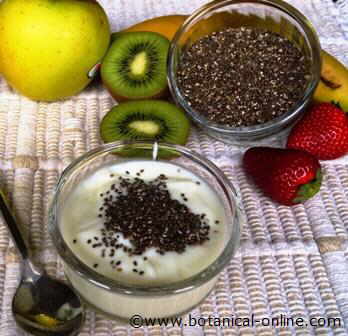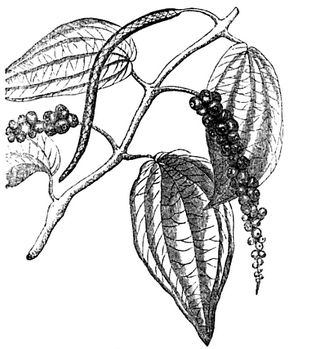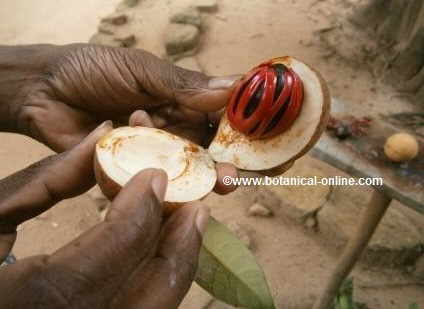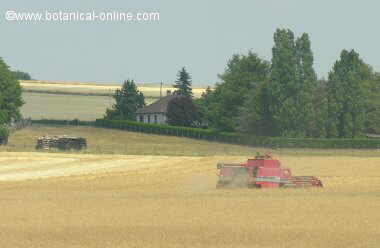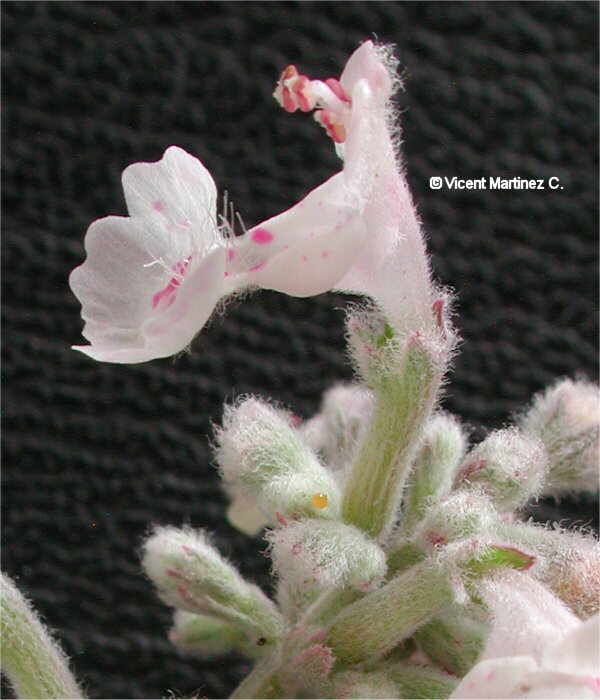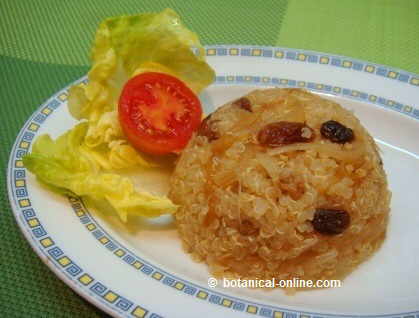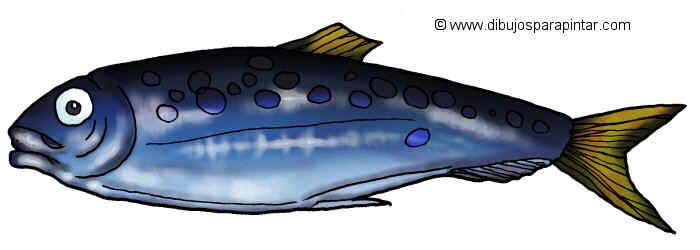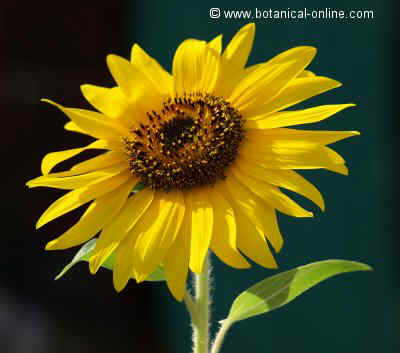Contents
- 1 (Plants of genders Calluna and Erica)
(Plants of genders Calluna and Erica)
DIFFERENT TYPES OF HEATHERS AND HEATHS IN THE WORLD
From a gardening point of view, when we speak of heather, we refer to three different genera:
– Genus Calluna, to which common heather (Calluna vulgaris) belongs
– Heath species belonging to the genus Erica.
– Heath species belonging to genus Daboecia
Although botanically they are different plants, they are all grouped within the same crop group because, in addition to being similar in shape, they share similar growing conditions except their resistance to cold.
Of course, common heather (Calluna vulgaris) can not withstand the same temperature conditions being a plant which, in the wild, lives in cold northern areas or in very high places than other heaths species living in warmer or even warmer areas.
However, leaving aside this consideration, the conditions of cultivation of all heathers and heaths , in terms of their water needs, light requirements, soil types, leaf permanence, resistance and ease of cultivation, etc. are practically the same .
How many kinds of heather or heaths are there?
Within the genus Calluna there is only one species, the common heather (Calluna vulgaris), although we have many cultivars obtained from this species. In the UK alone it is estimated that there are more than 400.
The genus Erica has more than 800 species of heaths , most of them native to South Africa. There are also some that are European and a smaller number distributed in other parts of Africa.
South African species are noted for their long tubular flowers. They are species that can only live in climates with mild winters. European species are very resistant to cold and are different from African species because they have smaller bell-shaped flowers. They are also more resistant to cold.
The Daboecia genus consists of only two species (Daboecia cantabrica and Daboecia azorica). They are two species of heath native to western Europe and the Azores, respectively. They produce flowers with the floral tube very narrow to the end.
The flowers of the genus Daboecia grow on leafless peduncles and, unlike the rest of heathers, the floral tube falls after flowering
Varieties of common heather (Genus Calluna)
Among the main varieties used in gardening we have some that stand out because they are very low (dwarf varieties) or very high. Others stand out because of the colors of their flowers or the color of their leaves. Among all of them, we highlight the following classes, types or varieties of heather in gardening:
Dwarf varieties:
– Calluna vulgaris “White Law”: 5 cm. White flowers.
– Calluna vulgaris “Multicolor”: 10 cm. Mauve flowers. Green-yellow leaves with orange and red dyes
– Calluna vulgaris “Sister Anne”: 10 cm. Mauve flowers. Greyish green leaves that turn brown bronze in winter.
– Calluna vulgaris “J.H. Hamilton”: 15 cm. Pink flowers
– Calluna vulgaris “County Wicklow”: 23 cm, pink flowers
– Calluna vulgaris “Dark Beauty”: 23 cm. Reddish pink flowers
Average Varieties
– Calluna vulgaris “Alba” or white heather: white flowers, 45-60 cm.
– Calluna vulgaris “Peter Sparkes”: 45 cm. Flowers dark pink.
– Calluna vulgaris “Robert Chapman”: 45 cm. Flowers purple pink. Golden leaves in spring that change to orange in autumn and red in winter.
– Calluna vulgaris “Beole Gold”: 45 cm. White flowers. Leaves with yellow shades.
– Calluna vulgaris “Hirsuta Typica”: 45 cm. Light mauve flowers. Stems and leaves with silver pilosity.
– Calluna vulgaris “Tib”: 45 cm. Dark purple flowers.
– Calluna vulgaris “Silver Queen”. 38 cm. Pale lilac flowers. Leaves with pubescence silvery white.
– Calluna vulgaris “Darkness”: 30 cm. Crimson Flowers
High varieties
– Calluna vulgaris “Elsi Purnell” 75 cm. Pink-silver flowers
– Calluna vulgaris “Annie Ann”: 60 cm. Mauve flowers.
– Calluna vulgaris “Gold Haze”: 60 cm. White flowers, with golden leaves.
– Calluna vulgaris “H. E. Beale”: 60 cm. Pink-silver flowers
– Calluna vulgaris “Serlei”: 60 cm. White flowers.
– Calluna vulgaris “Wickwar flame”: 60 cm. Pink-lilac flowers. Golden leaves.
Other species and varieties of heaths (Genus Erica or Daboecia)
MULTICONTINENTAL VARIETIES
– Erica arborea – Giant heath or tree heath: 600 cm. White flowers. Flowers in spring. It is the highest heath, being able to measure from about 20 cm to the more than 6 meters that reach some arboreal forms of Africa, where it forms part of the rainforest. In the Canary Islands it abounds in the Laurisilva. Its trunk is used in the manufacture of pipes.
It is the heath with a widest distribution, forming large groups scattered by different parts of the world (Mediterranean maquia, Portugal and Azores, East of equatorial Africa (The Ruwenzori chain, the mountains of the Cameroon, Plateau of Ethiopia). Zones 8-10
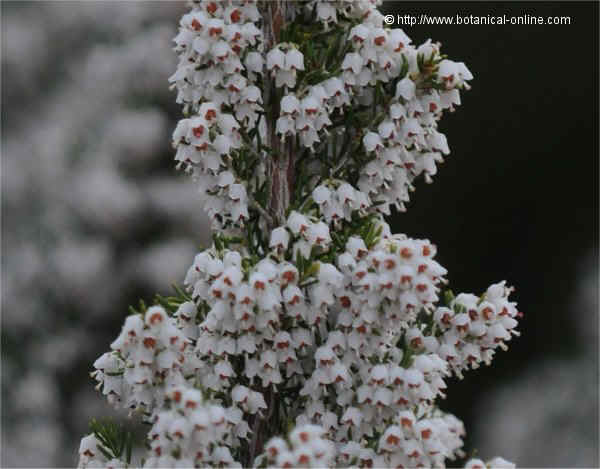
Flowers of giant heath (Erica arborea)
– Erica australis – Spanish Heath: 180 cm. West of the Iberian Peninsula and Morocco. Red-magenta flowers in spring.
SOUTH AFRICAN VARIETIES
– Erica bauera: – Albertinia heath, Bridal heath or Witheide. 100 cm. White or pink flowers. Zone 9-10
* Erica bauera “Alba”: 100 cm. Variety of white flowers. Zone 9-10
– Erica casta: 45 cm. White or purplish-pink flowers. Winter and spring flowering. Zones 9-10
– Erica dooliformis: 30 cm. Pink flowers. Zones 9-10
– Erica formosa – White heath, witheide: 100 cm. White flowers. Zones 9-10
– Erica grandiflora – Great-flowered Heath: 100 cm. Orange flowers. Flowering in the middle of summer. Zones 9-10
– Erica mammosa – Nine-pin heath: 100 cm. Red or dark pink flowers. Zones 9-10
– Erica perspicua – Prince of Wales heath, veerheide: 180 cm. White flowers, roses or dark mauve. Flowering in autumn and winter Zones 9-10
– Erica quadrangularis – Angled heath: 45 cm. White, red or pink flowers. Frost tender. Zone 10
– Erica regia – Elim heath, belletjieheide: 180 cm. White flowers with red edges or purple red. Windproof. Zones 9-10.
EUROPEAN SPECIES AND VARIETIES
– Erica carnea – Winter heath, Spring heath: 30 cm. Purple-pink flowers. Flowering in winter until mid-spring. Zones 5-9.
– Erica ciliaris – Dorset heath: 75 cm. Strong pink flowers. Varieties with white or pink flowers. Cultivars with golden leaves. Flowering from mid-summer to mid-winter. 7-9
– Erica cinerea – Bell heath: 45 cm. Pink or purple flowers, sometimes white. It blooms from early summer to early fall. Zones 5-9
* Erica cinerea “Kerry” variety with strong pink flowers.
* Erica cinerea “Crimsom king” variety with crimson flowers.
* Erica cinerea “Golden drop” variety with golden summer foliage.
– Erica x darleyensis – Darley Dale Heath. Pink heath of the Mediterranean: 60 cm. Pink flowers with very protruding stamens. Flowering from late autumn and all spring. It is a hybrid between Erica erigena and Erica carnea.
– Erica erigena – Heath of Ireland, Irish Heath: 180 cm. Pink flowers. Flowering in winter and spring. Zones 7-9
* Erica erigena “Alba Compacta” variety with white flowers.
* Erica erigena “Ewan Jones” variety with pink-mauve flowers.
* Erica erigena “Hibernica” variety with white flowers.
* Erica erigena “Silver Bells” variety with very aromatic white flowers.
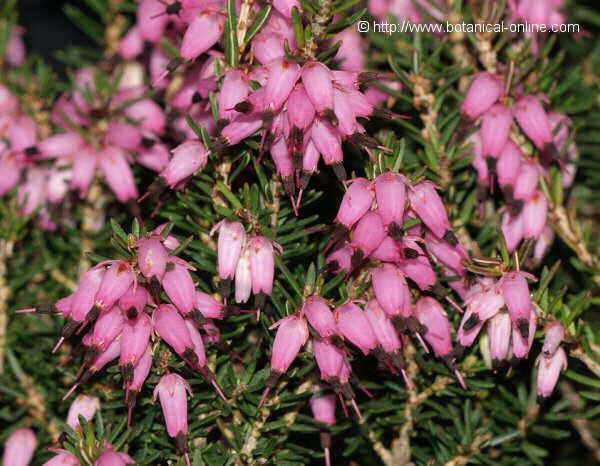
Irish heath flower (Erica erigena)
– Erica lusitanica – Portuguese heath or Spanish heath: 180 cm. White flowers with pale pink sparkles. It blooms in winter. Tolerant to calcareous soils. Not very tolerant to cold. Zones 8-10.
– Erica multiflora – Winter heath: 250 cm. White, pink or purple flowers. It blooms in autumn, winter and spring.
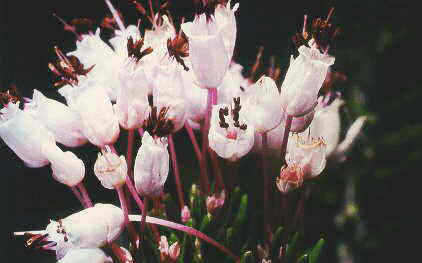
Winter heath flower (Erica multiflora)
– Erica tetralix – Cross-leaved heath: 30 cm. Light pink or white flowers larger than the rest of European heaths. Flowering in summer and autumn. It lives well in moist soils. Zones 5-9.
– Erica vagans– Cornish heath, wandering heath: 75 cm. White or mauve flowers. Flowering in summer and autumn. Zones 5-9.
– Erica X williamsii – William’s heath: Pale violet flowers. Flowering autumn and winter. Hybrid between Erica tetralix and Erica vagans. Zones 5-9.
Species and varieties of the genus Daboecia
We have two species of the genus Daboecia:
– Daboecia azorica – Azores heath: 20 cm. It is one of the less cultivated species because it resists cold less than other species. Strong red flowers. Flowering in summer. Zones 8 and 9
– Daboecia cantabrica – Connemara heath, St. Dabeoc’s heath: 60 cm. Pink-purple flowers. Flowering in summer and autumn. Zones 7-9
* Daboecia cantabrica “Alba”: Variety of white flowers. Zones 7-9
* Daboecia cantabrica “Atropurpurea”: Variety with strong purple flowers. Zones 7-9
* Daboecia cantabrica “Bicolor”: Variety with flowers purple and white. Zones 7-9
– Daboecia x scotica: 25 cm. Hybrid between Daboecia azorica and Daboecia cantabrica. Magenta flowers. Flowering from late spring to mid-autumn. Zones 7-9
* Daboecia x scotica “William Buchanan”: 35 cm. Variety of red-pink flowers. Zones 7-9
* Daboecia x scotica “Jack Drake”: 25 cm. Variety of red-ruby flowers. Zones 7-9
![]() More information on heather.
More information on heather.

